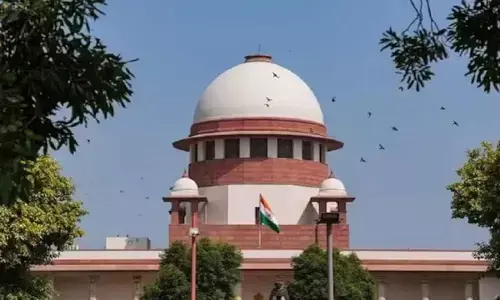Intrigue in Gupta Era: Srinivasan’s Saga

A historical writer and former civil servant, Harini Srinivasan, returns with her latest historical fiction, “Shadows and Secrets – The Pataliputra Conspiracy” (TreeShade Books), set in the Gupta period during the reign of Maharaja Chandragupta II Vikramaditya.
A historical writer and former civil servant, Harini Srinivasan, returns with her latest historical fiction, “Shadows and Secrets – The Pataliputra Conspiracy” (TreeShade Books), set in the Gupta period during the reign of Maharaja Chandragupta II Vikramaditya. Renowned poet-dramatist Mahakavi Kalidasa, a member of the Navaratnas (nine gems) in the Gupta Empire, resumes his role as the head of the state intelligence network, tasked with uncovering threats to the empire, both internal and external—a role previously assigned to him in “The Curse of Anuganga.” Pataliputra becomes the stage for a series of shocking murders, prompting Kalidasa to enlist Shaunaka, a young man from Nandivardhana, as an unofficial spy to help unravel the mystery and international conspiracy lurking beneath the surface.
This book intricately blends historical context, intrigue, and mystery against the backdrop of the Gupta Empire, marking Srinivasan’s second foray into historical detective fiction following “The Curse of Anuganga,” alongside her other works encompassing rom-coms and children’s fiction. Additionally, she has contributed significantly as an editor for various publications, including “Selected Speeches of the President: Pranab Mukherjee,” “The Republican Ethic: Selected Speeches of Shri Ram Nath Kovind,” “Indian Dance – Through a Critic’s Eye,” “Abode Under the Dome,” “Legends of Indian Silver Screen,” and “Selected Speeches of the Vice President: M. Venkaiah Naidu.”
Q. How did you conduct your research to accurately depict the Gupta era and the characters in your story?
To authentically portray any historical period, one must immerse themselves in its essence, integrating the era and its inhabitants into their own psyche. This process demands extensive reading and re-reading. I commenced my exploration of the Gupta period around 2015, delving into a diverse array of sources. These included academic works by scholars such as RC Majumdar and AS Altekar, classic literature like Kalidasa’s plays (albeit translated) and Sudraka’s “Mricchakatikam,” as well as contemporary literary works evoking ancient India, such as SL Bhyrappa’s “Saartha” and Nandini Sengupta’s Gupta period trilogy. Additionally, resources like Roshen Alkazi’s “Ancient Indian Costume” and Vatsyayana’s “Kamasutra” provided invaluable insights into daily life during that era. When encountering hurdles, platforms like JSTOR served as valuable references.
Q. Murders, plots, and a secret dating back a century are all part of the story. How did you combine these components to maintain reader interest and suspense?
These components are quintessential elements of any mystery narrative. My approach was to seamlessly integrate them within the backdrop of 5th-century India, while meticulously sketching the historical details of the bygone era. A successful historical novel strikes a delicate balance between historical accuracy and an engaging storyline. I endeavored to achieve this equilibrium, ensuring that readers are captivated by both the historical context and the unfolding mystery.
Q. What challenges did you face in crafting the character of Mahakavi Kalidasa, and how does his state intelligence network operate to thwart threats within the kingdom?
The primary challenge lay in imbuing Mahakavi Kalidasa with a fictional twist by appointing him as the head of the state intelligence network. Despite initial skepticism regarding the plausibility of a dramatist assuming such a role, Kalidasa’s unique position within Chandragupta II Vikramaditya’s court—as one of the Navaratnas and entrusted with tutoring the Vakataka princes—underscored his credibility and trustworthiness in the eyes of the king. Espionage was deeply entrenched in the political fabric of ancient India, with evidence suggesting the recruitment of spies from various societal strata. Kalidasa’s network leveraged individuals from diverse backgrounds—monks, robbers, merchants, and others—to gather intelligence vital for safeguarding the kingdom.
Q. This is the second mystery featuring Shaunaka, a fictional character unlike Kalidasa and others. Why was his inclusion significant to the story and plot?
Shaunaka, introduced in “The Curse of Anuganga,” embodies intelligence, curiosity, and a desire for exploration. Expanding his worldview and journeying to Pataliputra allowed for a deeper exploration of his character, both as a spy and as a human being.
I was particularly fascinated by the dynamics of trade routes and guilds in ancient India, as well as the experiences of individuals traveling within caravans. Setting the narrative in Pataliputra provided an opportunity to seamlessly integrate Shaunaka’s journey from Nandivardhana and showcase the intricacies of ancient travel and commerce.
Q. To what extent are you a history enthusiast, and what would you recommend to readers seeking to delve deeper into the Gupta period?
My passion for history is fundamental to my pursuit of writing historical fiction. For readers eager to delve into the Gupta period, I recommend the works of historians such as RC Majumdar and AS Altekar. Additionally, Vatsyayana’s “Kamasutra” offers a vivid depiction of life as a nagaraka (city dweller) during this era. Nandini Sengupta’s Gupta period trilogy provides an engaging fictional exploration of the period.














